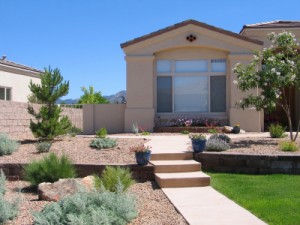5 Xeriscaping Basics
Guest Post by Marcy Tate is a home improvement blogger at Networx.com
How to Make Low-Water Landscaping Work for You
 For many homeowners, the word xeriscape is enough of an intimidation that they are too scared to investigate what it means or how it can benefit them. But I am here to remove that intimidation and tell you that xeriscaping is nothing more than utilizing low-water landscaping techniques.
For many homeowners, the word xeriscape is enough of an intimidation that they are too scared to investigate what it means or how it can benefit them. But I am here to remove that intimidation and tell you that xeriscaping is nothing more than utilizing low-water landscaping techniques.
You may be wondering where this term came from. It was originally created by several Denver Water (the water department of Denver) employees in the late 1970s. The term is derived from the Greek word “xeros,” meaning “dry,” and “scape,” meaning a view or scene. For the past couple of decades, xeriscaping techniques have been mostly practiced by homeowners living in desert climates. In the past few years, homeowners throughout the US have begun xeriscaping, as the wonderful benefits have become more pronounced for those living in all climates.
The goal of xeriscaping is to produce a healthy and thriving garden while conserving water, lowering your water bill and minimizing any negative environmental impacts caused by conventional gardening and landscaping techniques. Applying initial xeriscaping techniques requires a bit more
planning, time and patience at first. However, once your xeriscaped garden is planted, you’ll save time as well as money. Here’s how to do it:
- Condition the soil to help it retain moisture. You can do this by adding the proper amounts of compost, manure, humus (can be purchased at your local nursery) and organic fertilizer.
- Use a drip irrigation system with a timer. Drip irrigation systems are significantly more efficient than sprinklers and in-ground sprinkler systems. A drip irrigation system essentially consists of a hose with tiny holes along it. This allows water to trickle slowly into the soil over long periods. This type of water delivery prevents water runoff and evaporation, thus saving water.
- Limit the amount of turf on your property. Instead of having large grassy areas, use mulch and groundcovers. Grass is beneficial and important for children and pets. Incorporate some in your xeriscape plan, but use mulch and groundcovers wherever practical. This will directly cut down on the time you spend mowing and maintaining your lawn. Additionally, as water rates increase and as more cities across the US enforce water restrictions, there’s no better way to avoid brown grass then by just not having large areas of it.
- Plant native and drought-tolerant plants, as doing so will reduce the need for watering. Check with your local nursery or gardener to find out which native plants are ideal for your area. Group plants with similar water needs together. Place plants that are most water-dependent in shaded areas to limit evaporation.
- Place mulch over the soil. Doing so will reduce erosion and retain moisture. With the vast selection of mulch types, you’ll be able to find mulch that complements the color of your home’s exterior.
Overall, applying xeriscaping techniques is a very accessible and simple process. Additionally, using common sense, such as checking the weather forecast before watering, will help you save even more.
—-
Marcy Tate is a home improvement blogger at Networx.com. She has been working with gardeners, learning about ways to teach homeowners how to apply xeriscaping techniques.













Leave a comment